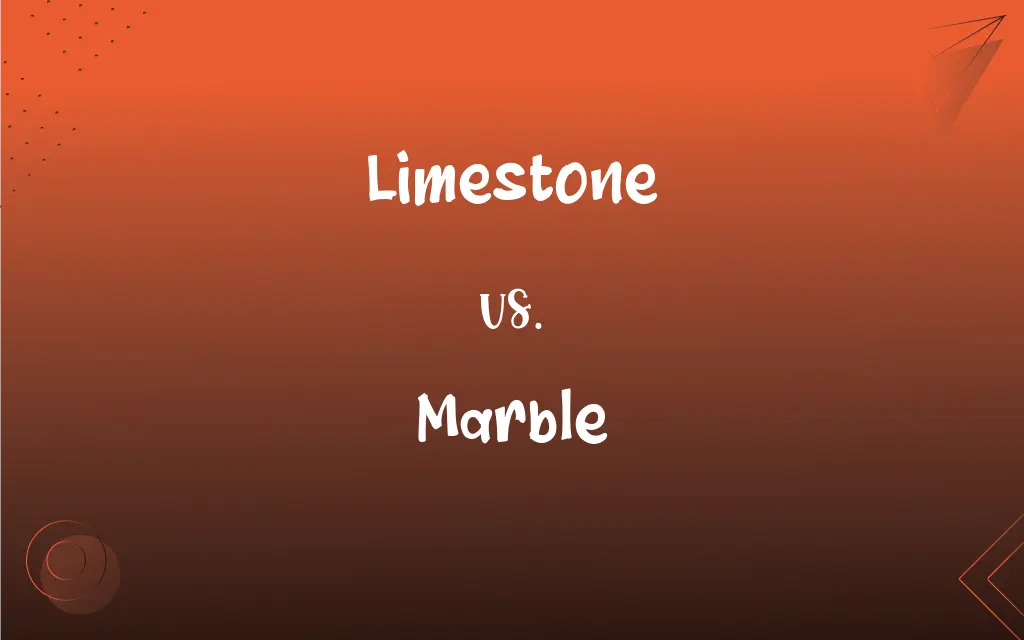Limestone vs. Marble: What's the Difference?
Edited by Aimie Carlson || By Janet White || Published on January 4, 2024
Limestone is a sedimentary rock composed mainly of calcite, while marble is a metamorphic rock formed by the metamorphism of limestone, known for its crystalline structure and used in sculpture and architecture.

Key Differences
Limestone is a sedimentary rock, formed primarily from the mineral calcite, often derived from the accumulation of shell, coral, algal, and fecal debris. Marble, however, is a metamorphic rock that originates as limestone and undergoes metamorphism under high pressure and temperature, leading to a more crystalline structure.
The texture of limestone is typically granular and can include fossils and layers, indicative of its sedimentary origin. Marble is characterized by its medium to coarse grains and uniform texture, lacking the layering found in limestone, a result of its metamorphic transformation.
Limestone is generally softer and more porous than marble, making it less durable for certain applications. Marble, due to its metamorphic nature, is harder and less porous, making it more suitable for fine sculpture and building materials.
Limestone often appears in a spectrum of natural, earthy colors due to impurities like clay, sand, and organic remains. Marble, known for its elegance, typically showcases a range of colors with veins running through it, created by mineral impurities like silt, sand, and iron oxides.
In terms of applications, limestone is widely used in construction, aggregate, and agricultural lime. Marble is preferred in art, architecture, and as a building material for its aesthetic appeal and durability.
ADVERTISEMENT
Comparison Chart
Composition
Mainly composed of calcite, often with fossil inclusions
Metamorphosed limestone, primarily calcite
Texture
Granular with possible fossils and layers
Uniform, crystalline texture without layers
Hardness and Porosity
Softer and more porous
Harder and less porous
Color and Appearance
Natural, earthy tones with impurities
Range of colors with distinctive veins
Common Uses
Construction, aggregate, agricultural lime
Sculpture, architecture, building material
ADVERTISEMENT
Limestone and Marble Definitions
Limestone
Limestone forms from the accumulation of shell, coral, and algal debris.
The limestone cliffs were rich in fossilized marine life.
Marble
Marble is a metamorphic rock formed from the metamorphism of limestone.
The Taj Mahal is renowned for its extensive use of white marble.
Limestone
Limestone is known for its granular texture and earthy colors.
Limestone flooring added a natural feel to the house.
Marble
Marble is used in sculpture and building materials for its durability.
The kitchen countertops were made of luxurious Italian marble.
Limestone
Limestone is a sedimentary rock primarily composed of calcite.
The ancient pyramids were built using limestone blocks.
Marble
Marble is characterized by a crystalline texture and often has veins.
The marble statue stood out for its intricate veining.
Limestone
Limestone is used in construction and as a raw material in cement.
They quarried limestone for the new building’s foundation.
Marble
Marble is less porous and harder than limestone.
The marble tiles were chosen for their durability in high-traffic areas.
Limestone
Limestone often contains fossils and is less durable than marble.
The limestone rock in her garden displayed visible fossils.
Marble
Marble comes in various colors, typically with a polished finish.
The marble floor had a high gloss, reflecting the light beautifully.
Limestone
A common sedimentary rock consisting mostly of calcium carbonate, CaCO3, used as a building stone and in the manufacture of lime, carbon dioxide, and cement.
Marble
A metamorphic rock formed by alteration of limestone or dolomite, often irregularly colored by impurities, and used especially in architecture and sculpture.
Limestone
An abundant rock of marine and fresh-water sediments; primarily composed of calcite (CaCO3); it occurs in a variety of forms, both crystalline and amorphous.
Marble
A piece of this rock.
Limestone
Pertaining to or made of limestone.
Limestone
A rock consisting chiefly of calcium carbonate or carbonate of lime. It sometimes contains also magnesium carbonate, and is then called magnesian or dolomitic limestone. Crystalline limestone is called marble.
Limestone
A sedimentary rock consisting mainly of calcium that was deposited by the remains of marine animals
FAQs
What is limestone made of?
Limestone is mainly composed of calcium carbonate.
Can limestone contain fossils?
Yes, limestone often contains fossils and shells.
How is marble formed?
Marble forms from limestone under high pressure and temperature.
Is marble harder than limestone?
Yes, marble is generally harder and less porous than limestone.
Is limestone suitable for outdoor use?
Limestone is used outdoors but is less durable than marble.
Are there different colors of limestone?
Yes, limestone can vary in color based on its mineral content.
Can marble be used for flooring?
Yes, marble is popular for flooring due to its aesthetic appeal.
What are the uses of marble?
Marble is used in sculpture, building decor, and fine architecture.
Is limestone good for countertops?
Limestone can be used for countertops, but it's less durable than marble.
What is the main difference in texture between limestone and marble?
Limestone is granular, while marble has a more uniform texture.
Are both limestone and marble used in construction?
Yes, both are used, but in different applications due to their properties.
Are there synthetic alternatives to these rocks?
Yes, there are synthetic materials that mimic both limestone and marble.
Can both rocks be polished?
Yes, both can be polished, but marble typically has a higher sheen.
How does weather affect limestone and marble?
Both can be affected by weathering, but marble is more weather-resistant.
Can limestone and marble be recycled?
Yes, both can be repurposed or recycled for various uses.
Is marble more expensive than limestone?
Generally, marble is more expensive due to its aesthetic and durability.
What is the environmental impact of quarrying these rocks?
Quarrying can impact local ecosystems and landscapes.
Can limestone be used in high-traffic areas?
It's less ideal for high-traffic areas due to its softer nature.
Are there cultural significances to these rocks?
Yes, both have been used historically and culturally in architecture and art.
How is marble maintained?
Marble requires regular sealing and careful cleaning to prevent stains.
About Author
Written by
Janet WhiteJanet White has been an esteemed writer and blogger for Difference Wiki. Holding a Master's degree in Science and Medical Journalism from the prestigious Boston University, she has consistently demonstrated her expertise and passion for her field. When she's not immersed in her work, Janet relishes her time exercising, delving into a good book, and cherishing moments with friends and family.
Edited by
Aimie CarlsonAimie Carlson, holding a master's degree in English literature, is a fervent English language enthusiast. She lends her writing talents to Difference Wiki, a prominent website that specializes in comparisons, offering readers insightful analyses that both captivate and inform.







































































